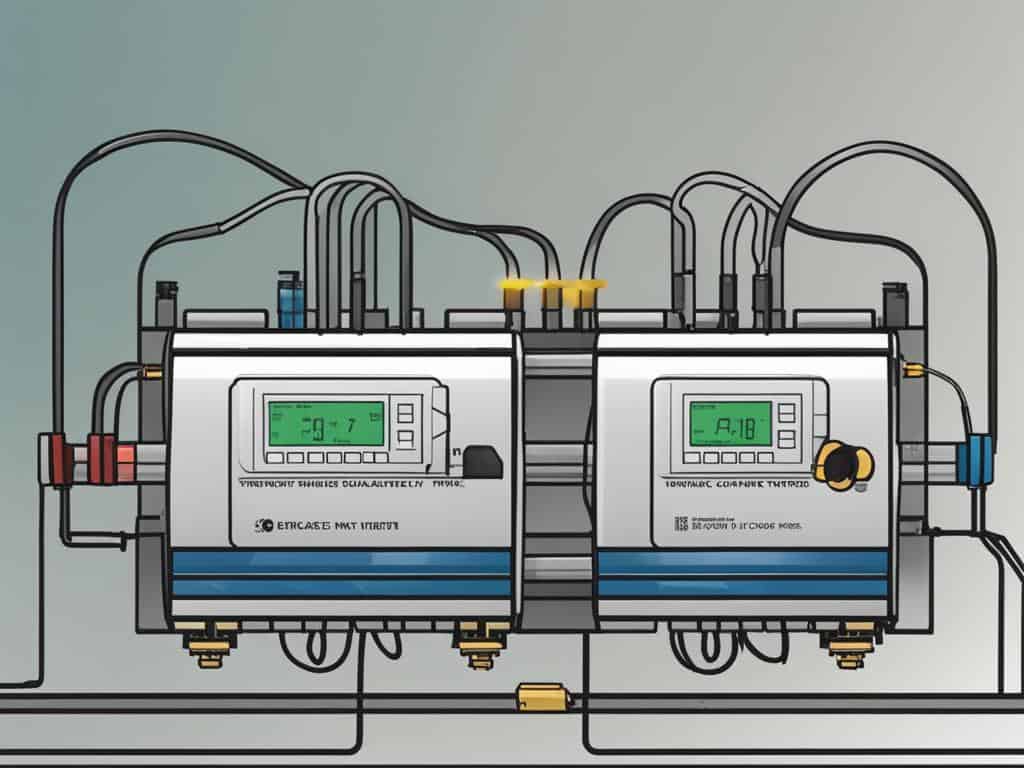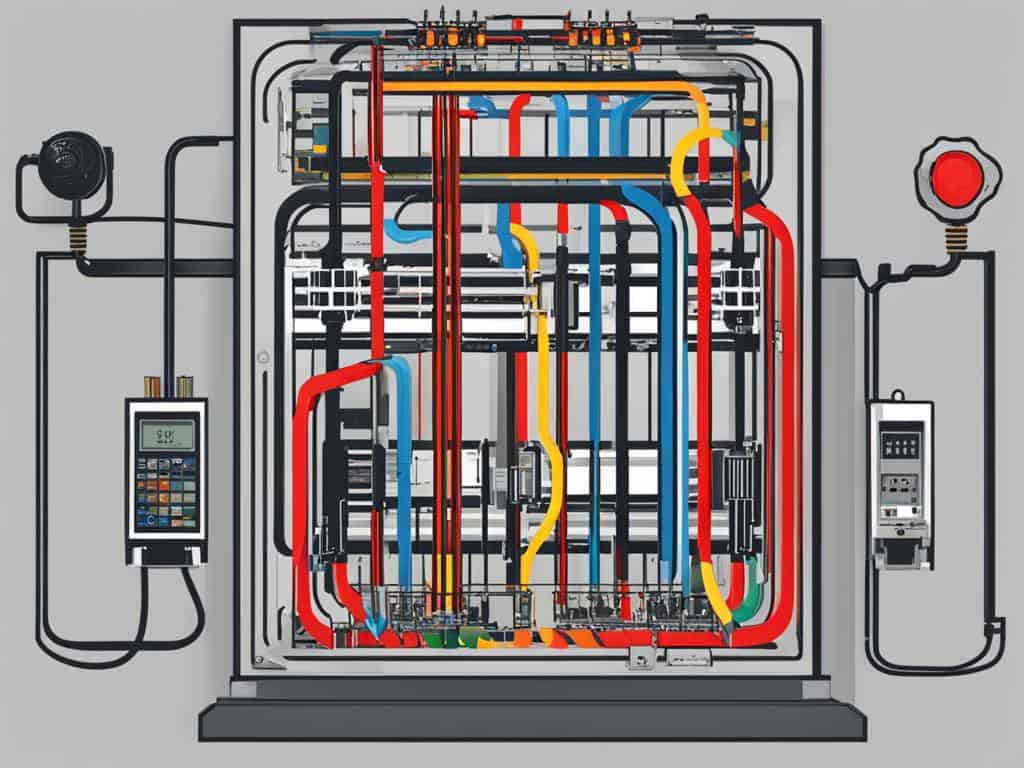Power Distribution: Understanding 3-Phase Meter Load Capacity
Explore the essentials of 3 phase meter load capacity for efficient power management and safe electrical load distribution in India.

In India, 3 phase meter load capacity serves as the foundation of industrial power. It’s crucial for measuring and distributing power throughout the grid. Have you thought about your electric utility meter capacity? Wonder if you’re using your power supply to its fullest? Let’s explore the 3-phase power system’s abilities and limits.
In India, having a sturdy electrical load capacity can mean smooth work without interruptions. Knowing about three phase power measurement is more than technical; it’s key for business growth. We will dive into 3-phase meters and see how managing their capacity can boost your power distribution efficiency.
Key Takeaways:
- Discover the essential role of 3-phase meters in India’s power distribution networks.
- Understand how to fully leverage your 3 phase meter load capacity for optimal performance.
- Learn the significance of electric utility meter capacity for industrial energy management.
- Gain insights into how electrical load capacity in India impacts commercial power usage.
- Explore the practical benefits and calculations involved in three phase power measurement.
Exploring Three-Phase Power and Its Advantages
Three-phase electrical power system is at the heart of modern electricity. It’s widely used in industries and data centers in India. This system helps manage high power needs efficiently, making it perfect for a fast-growing economy. It’s known for its ability to handle large loads, making it essential for India’s growth.

Core Principles of Three-Phase Power Systems
Three-phase power is favored for its cost-effective power distribution. Its advanced design allows for efficient power supply. This design is better than single-phase options, ensuring consistent power in all areas of India.
Higher Efficiency in Transmission and Distribution
Three-phase power is best for covering India’s vast areas. It allows for easy voltage changes and consistent power delivery. This improves the power quality with minimal loss, setting a new bar in efficiency.
Reducing Material Costs with Polyphase Systems
India is moving towards polyphase systems, like three-phase power, to cut down on cable size and cost. This approach is not only cheaper but also better for the environment. It takes advantage of three-phase power’s high load handling.
| Aspect | Single-Phase Power | Three-Phase Power |
|---|---|---|
| Efficiency | Lower Efficiency | High Efficiency due to constant power transfer |
| Cable Requirement | Larger and More Expensive Cabling | Reduced Cable Size and Cost |
| Load Rating | Lower Load Rating | High Load Metering Capabilities |
| Cost Implications | Higher Long-term Costs | Cost-effective Power Distribution |
| Adaptability | Less Adaptable to Heavy Industrial Use | Robust and Adaptable across Various Industries |
Three-phase meter technology is key to a strong electrical system in India. It boosts efficiency, economic benefits, and sustainable development. India will greatly benefit from these systems.
Key Components of a 3-Phase Meter Load Capacity Setup
In the world of electrical distribution systems, the 3 phase meter load capacity is very important. It helps keep power distribution in India stable and working well. Understanding these parts is key for industries and commercial places to use energy well.
The 3-phase meter uses three conductors. Each carries current at a 120-degree phase difference. They are colored as Phase 1 (Red), Phase 2 (Yellow), and Phase 3 (Blue). A neutral wire (White) returns unbalanced currents. For safety and efficiency, skilled electricians do the setup. They make sure cables and earthing systems are set up right.
Here is how meter load capacity relates to a 3-phase setup’s parts. This link is key to figuring out the right energy use. It stops the system from getting overloaded. A meter load capacity calculator helps with this.
| Component | Description | Function |
|---|---|---|
| Phase 1 (R) | One of the three AC current conductors | Carries part of the load; engaged in three-phase power supply |
| Phase 2 (Y) | One of the three AC current conductors | Supplies power in conjunction with the other two phases |
| Phase 3 (B) | One of the three AC current conductors | Completes the trio for balanced power distribution |
| Neutral Wire (N) | A wire providing a return path | Facilitates the flow of unbalanced currents back to the system |
The 3 phase meter load capacity helps India’s industrial and commercial areas a lot. It provides more power and makes energy use stable and reliable. This isn’t just about having enough power. It also means saving costs and managing energy better. Such systems help businesses stay strong in a changing world. They make companies like Fenice Energy seek better energy use methods.
Creating a strong 3-phase meter setup is key for reliable electrical systems. It leads to a future with dependable and smart energy solutions.
3 Phase Meter Load Capacity: Calculating and Maximizing Potential
Understanding three-phase meters is key for better power management in commercial and industrial areas in India. By looking into how these meters calculate loads and their use daily, one can maximize their benefits. Fenice Energy is at the forefront, providing clean energy solutions with high-capacity meters.
Understanding the Calculation: The Role of Square Root of 3
To get meter capacity right, knowing how to calculate three-phase power is a must. This calculation uses a special formula, which includes multiplying by the square root of 3 (about 1.732). This gives us a higher voltage and shows what the meter’s load rating should be for safety.
Practical Applications and Real-World Examples
Three-phase meters are used in many places with high power needs. They are important in factories, commercial centers, and farms. These meters help these places use power efficiently, pushing India forward in energy use.
Creative Solutions by Fenice Energy in Harnessing 3-Phase Power
Fenice Energy focuses on clean energy, using three-phase meters in smart ways. They apply this technology in solar panels, backup systems, and EV charging stations. This shows how these meters can change industries and homes for the better. Fenice Energy aims to make systems that are effective, reliable, and good for the planet.
Learning about meter load calculators to seeing their impact shows how crucial three-phase meters are. As companies need reliable power, Fenice Energy’s solutions light the path for India’s clean energy future.
Conclusion
In India, as business grows, measuring power correctly becomes very important. Using a 3-phase system lets companies use energy more efficiently. It’s good for saving energy, costs, and keeping power supply steady.
Fenice Energy helps with expert setup and smart use of 3-phase meters. This means better energy use and helps with India’s energy goals. They make sure the country’s growing needs are met with dependable power meters.
Looking ahead, 3-phase meters are key for modern energy systems. They help plan for a future where energy needs meet careful use. Fenice Energy is committed to making India’s power network better. They focus on meeting the demands of its people and businesses.
FAQ
Q: What is the importance of a 3-phase meter load capacity in electrical distribution systems?
A: A 3-phase meter load capacity is crucial in managing electricity well in electrical grids. This is very important in India for industries and farms. It ensures that electricity use is safe and without overloading the system.
Q: How does three-phase power improve efficiency for power transmission and distribution?
A: Three-phase power ensures power is always available in a balanced way. It’s better than single-phase for sending power far distances. This system makes it easy to change power to high or low voltages for efficient use. That’s why it’s chosen by most electric utilities.
Q: What are the cost benefits of using a polyphase system like the three-phase power supply?
A: Polyphase systems such as three-phase power use less wire for the same power, saving materials and money. The balanced system needs smaller neutral wires, cutting down further costs. It keeps the load metering high but economical.
Q: What are the core components of a 3-phase meter?
A: The main parts of a 3-phase meter are three conductors. Each conductor carries a current. They are out of sync by 120 degrees, known as Phase 1 (R), Phase 2 (Y), and Phase 3 (B). Sometimes there’s a neutral wire (N) for uneven currents. Correct installation by certified electricians is very important.
Q: How do you calculate the power capacity of a 3-phase meter?
A: To figure out a 3-phase meter’s power capacity, there’s a special formula. It involves multiplying the voltage by the square root of 3 (about 1.732). This method takes the phase difference into account for correct power measurements. It ensures energy is managed safely and effectively.
Q: In which sectors are three-phase meters commonly implemented in India?
A: Three-phase meters are common in several areas in India. They are in industrial places for big machines, farms for water systems, and big buildings like offices and malls. They ensure power is stable and balanced, vital for efficient work in these areas.
Q: What innovative solutions does Fenice Energy offer in relation to 3-phase power?
A: Fenice Energy focuses on new clean energy methods using 3-phase power. They offer systems for solar energy, power back-ups, and charging stations for electric vehicles. These help manage power well in homes and industries across India.
Q: Why is the role of 3-phase power and meter load capacity growing in importance in India?
A: As India grows in its industrial and business activities, the need for more power and efficient distribution increases. Using 3-phase power and understanding meter capacity is key. It helps meet these needs while saving costs and improving operations.


